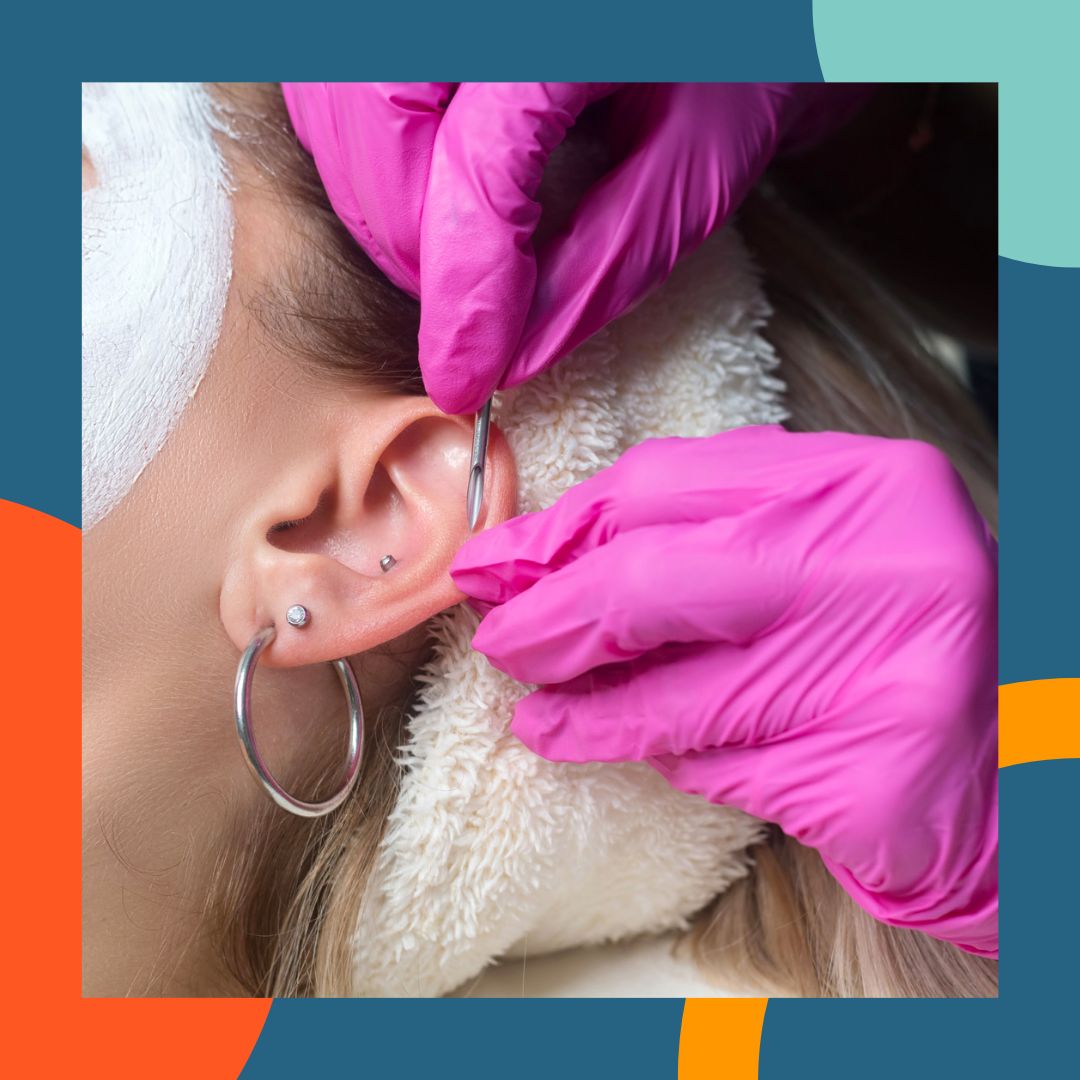Ear piercings have been a popular form of self-expression and adornment for centuries. From simple lobe piercings to intricate cartilage piercings, there are endless possibilities for those looking to accessorize their ears. As someone who has had multiple piercings over the years, I understand the allure and excitement of getting a new piercing. However, with so many different types of piercings and aftercare procedures to consider, it can be overwhelming for first-timers.
This article will cover everything you need to know about ear piercings, from the different types of piercings to the piercing process, aftercare, jewellery options, where to get pierced, and more. By the end of this article, you’ll be equipped with all the information you need to make an informed decision about your next piercing.
Different Types of Ear Piercings
Piercings come in many shapes and sizes, each offering a unique way to express yourself through jewellery. Here are some of the most popular types:

Lobe Piercing: The most common and most straightforward type. A small hole is made in the fleshy part of the earlobe.
Cartilage Piercing: Any piercing that goes through the cartilage of the ear is considered a cartilage piercing. This includes helix, forward helix, tragus, anti-tragus, conch, and rook piercings.
Helix Piercing: A piercing that goes through the upper rim of the ear.
Tragus Piercing: A piercing located on the small, triangular flap of cartilage in front of the ear canal.
Conch Piercing: A piercing in the inner part of the ear, specifically the open shell-shaped area.
Daith Piercing: A piercing located in the innermost fold of cartilage in the ear.
Rook Piercing: A piercing located above the daith, in the cartilage fold between the inner and outer conch.
Forward Helix Piercing: A piercing located on the rim of the cartilage closest to the head, just above the tragus.
Anti-Tragus Piercing: A piercing opposite the tragus, on the outer edge of the ear.
Snug Piercing: A piercing located through the inner cartilage of the ear, parallel to the outer edge of the ear.
Industrial Piercing: Also known as a scaffold piercing, this involves two piercings connected by a single barbell, usually done in the ear’s upper cartilage.
Orbital Piercing: Two piercings in the ear that are connected with a single piece of jewellery.
Auricle Piercing: A piercing located in the middle of the ear’s outer rim.
Flat Piercing: A piercing located on the flat part of the ear, above the anti-tragus.
Outer Conch Piercing: A piercing in the outer part of the conch, located in the middle of the ear.
Inner Conch Piercing: A piercing in the inner part of the conch, located near the ear canal.
These are just a few of the most popular types of ear piercings, but there are many more to choose from. It’s essential to research and consult with a specialist to determine which one is right for you.
Piercing Process and Aftercare
Getting a piercing can be an exciting experience, but knowing what to expect during and after the process is necessary. First and foremost, it’s essential to find a reputable specialist who uses sterile equipment and takes steps to minimize the risk of infection.
When you arrive at the piercing studio, you’ll be asked to complete some paperwork and discuss your desired piercing with the piercer. They’ll explain the process, mark the spot where the piercing will be placed, and have you approve the location. Then, they’ll use a hollow needle to create a hole in your ear and insert the jewellery.
After the piercing, following proper aftercare procedures is essential to promote healing and prevent infection. This typically involves cleaning the piercing with a saline solution or mild soap and water, avoiding touching the piercing with dirty hands, and avoiding swimming or submerging the piercing in water for a while. It’s also essential to avoid changing the jewellery too soon, as this can disrupt the healing process.
Piercing requires effort and care, but it’s well worth it to achieve the look you want while keeping your ear healthy and free of infection. Be sure to follow your piercer’s aftercare instructions closely, and don’t hesitate to reach out to them if you have any questions or concerns.
Choosing the Right Jewellery
Choosing the right jewellery for your new ear piercing is just as important as the piercing itself. Wearing the wrong type of jewellery can lead to discomfort, infection, and even prolonged healing times.
When selecting the right jewellery, there are a few key factors to consider. First, it’s crucial to choose a hypoallergenic material that won’t cause an allergic reaction. Some popular options include surgical steel, titanium, and 14k gold.

Next, you’ll want to select the appropriate size and style of jewellery. The jewellery size will depend on the piercing you have and the length of the healing period. You’ll want to avoid too tight jewellery, as this can impede the healing process, or too loose, as it can snag on clothing or hair.
The style of jewellery you choose will largely depend on your taste, but selecting a design that will stay in the way of your daily activities is essential. For example, if you have an active lifestyle, choose a simple stud or hoop that won’t get caught on clothing or equipment.
Ultimately, the right jewellery for your new piercing will depend on various factors, including the type of piercing, your personal taste, and your lifestyle. Consult your piercer and ask for their advice when selecting your new jewellery. You can enjoy your new piercing while keeping your ear healthy and comfortable with the right choice.
Where to Get Pierced
When it comes to getting your ears pierced, various options are available. From mall kiosks to speciality piercing studios, choosing a reputable and safe location is essential to ensure a positive experience.
One option is to go to a piercing studio. These specialized studios have experienced piercers trained in safe and effective techniques. They also typically use higher-quality jewellery and follow strict hygiene practices to minimize the risk of infection. While piercing studios may be more expensive than other options, they offer the highest professionalism and expertise.

Another option is to visit a tattoo shop. Many tattoo shops also offer piercing services, and they typically have experienced piercers on staff. While tattoo shops may have a different level of specialization than piercing studios, they can still provide safe and effective piercings.
Finally, some beauty salons and retail stores offer in-store piercing services. While these locations may be convenient and affordable, they may have different expertise and safety protocols than a piercing studio or tattoo shop. It’s essential to research and choose a location with a good reputation and track record.
No matter where your ears are pierced, ask about the process, aftercare instructions, and the types of jewellery available. Be bold, ask questions, and ensure that the piercer uses safe and sterile techniques. You can enjoy a safe and comfortable piercing experience with the right location and piercer.
What People Says
Elizabeth Pedraza says: Hey guys, I just wanted to share my recent ear piercing experience with you all. First and foremost, I want to stress the importance of health and safety when getting a piercing. Make sure to go to a reputable piercer who uses clean equipment and practices proper hygiene.
As for your new piercing, follow the aftercare instructions provided by your piercer. It’s essential to keep the area clean and avoid touching it too much. And while there are many cool ear piercings out there, it’s vital to consider the location of the piercing and how it might affect the inner part of your ear and the ear cartilage.
It’s also worth noting that ear piercings can take up to a year to fully heal, so be patient and diligent with your aftercare routine. And when it comes to piercing earrings, make sure to choose a material that is suitable for your skin and won’t cause irritation.
Lastly, remember that while piercings may look great on the lobe and the helix, it’s essential to consider the potential risks and decide what is right for you. Overall, just be smart and safe regarding ear piercings, and you’ll have a stylish and healthy addition to your personal style.
FAQs
What should I know before getting my ears pierced?
What not to do when you first get your ears pierced?
How long do your ears hurt after piercing?
How do you sleep with a pierced ear?
Can I shower with new piercings?
Can you get your ears wet after piercing?
Should I rotate my ear piercing?
Can I change my earring after 1 week?
What foods should you avoid after an ear piercing?
Is a gun better than a needle for ear piercing?
What hurts more: hand or gun piercing for the ear?
Why do I feel dizzy after piercing?
What hurts more: tattoos or piercings?
How do I know if my body is rejecting a piercing?
Should I eat before a piercing?
When should you not get a piercing?
How do I prepare my body for a piercing?
Conclusion
Ear piercing is a popular and timeless form of body modification that can add a unique touch to your personal style. With so many types of piercings, jewellery options, and places to get pierced, it can be overwhelming to navigate the world of shooting. However, with some research and preparation, you can make an informed decision and enjoy a safe and successful piercing experience.
Remember to choose a reputable location with a trained and experienced piercer who follows strict hygiene practices. Ask questions and ensure you fully understand the piercing process and aftercare instructions. And, of course, have fun exploring the different types of jewellery and piercings to find a look that fits your personal style.
With these tips in mind, you’ll be well on your way to enjoying a stylish and successful piercing. So go ahead and rock that tragus, helix, or conch piercing – the endless possibilities!


